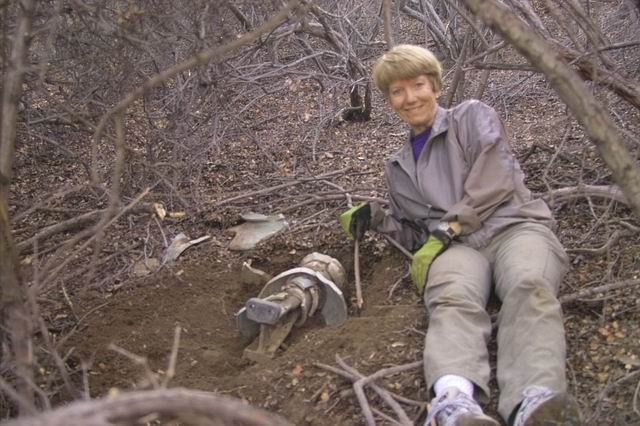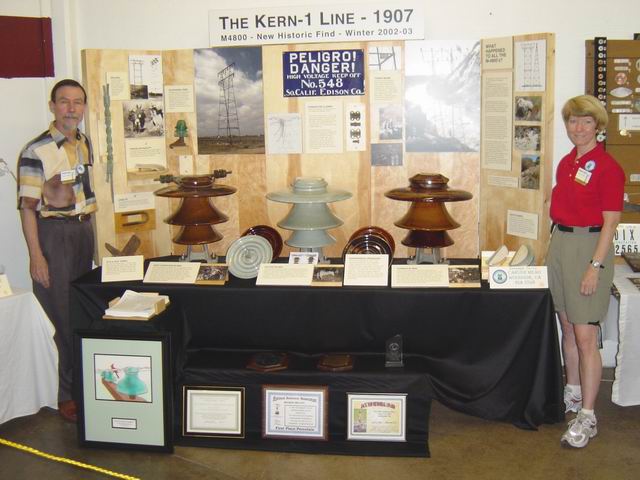
The Kern-1 Line - 1907
M-4800 "Largest Insulator Used for Long-Distance Transmission"
New Historic Find - Winter 2002-03
By Carver Mead & Barbara Smith
[Carver and Barb presented a display at the 2003 Springfield, OH NIA National show that won seven awards!! They graciously gave me permission to reprint the handout for their display with many of photos. Before their discoveries, there was only one M-4800 known. It has a dark brown glaze and was made by Thomas. After much research and great effort, Carver and Barb were rewarded with a huge success by finding three M-4800's made by three different manufacturers. I'm sure you will enjoy reading their fascinating story!!]

There is a long-standing mystery concerning the fate of the huge multipart insulators used on the Kern 1 line. Over 8000 of these lily-shelled beauties were installed in 1907. They were replaced with suspension strings in 1916. Up to 2002, none had ever been found.
Where did they all go? Elton Gish's book Multipart Porcelain Insulators, starting on page 80, contains an excellent synopsis of the state of our knowledge of the line as of the year 2000. After spending some time with Mike Spadafora and hearing his frustration at finding only broken pieces, we became determined to solve the mystery. We spent the winter of 2002-03 pouring over old maps, studying the original Electrical World article describing the line and most important, fighting our way through the brush on the right-of-way to gather first-hand information on the line. Solving the mystery led to the discovery of restorable specimens from all three manufacturers: Victor, Thomas, and New Lexington.What Happened to all the M-4800's? The original article (Electrical World, August 31, 1907, p401) contains the following statement: "The foot plates of the towers are of cast iron, dipped in asphalt, and 24 in. in diameter. They are attached at the bottom to 4 X 4 in. foot posts, which are asphalted on top of the galvanizing. These posts are bolted as extensions to the corner posts of the tower, and set in the ground a depth of 6 ft. Tapered holes were dug for these foot plates and the earth was tamped back on them very carefully. No concrete footings were used, except on some special work in the city of Los Angeles, where a great many of the tower heights exceeded 60 ft."
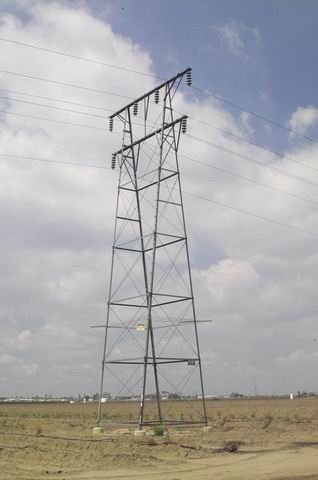 We
noticed that most of the towers we encountered were mounted on concrete footings
--- what had happened? We found a site where the foundations of the tower
had been bulldozed out, concrete and all, so we could see what had
happened. The concrete encased the foot posts for about 4 ft. under the
ground, leaving a short section of the bottom of the foot post and the foot
plate buried in the ground, just where they had been originally. Obviously
this had been a retrofit --- but when? There were an inordinate number of
M-4800 parts scattered on the surface at this particular location. On
closer inspection, the concrete piers had pieces of broken insulator porcelain
sticking out of the side! It then became apparent what had happened. The
concrete foundations were added in 1916, as the line was being upgraded with
suspension insulators. There were open holes in the ground when the
insulators were being changed. Where better to dispose of those heavy,
useless 4800's!
We
noticed that most of the towers we encountered were mounted on concrete footings
--- what had happened? We found a site where the foundations of the tower
had been bulldozed out, concrete and all, so we could see what had
happened. The concrete encased the foot posts for about 4 ft. under the
ground, leaving a short section of the bottom of the foot post and the foot
plate buried in the ground, just where they had been originally. Obviously
this had been a retrofit --- but when? There were an inordinate number of
M-4800 parts scattered on the surface at this particular location. On
closer inspection, the concrete piers had pieces of broken insulator porcelain
sticking out of the side! It then became apparent what had happened. The
concrete foundations were added in 1916, as the line was being upgraded with
suspension insulators. There were open holes in the ground when the
insulators were being changed. Where better to dispose of those heavy,
useless 4800's!
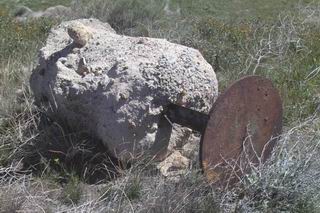
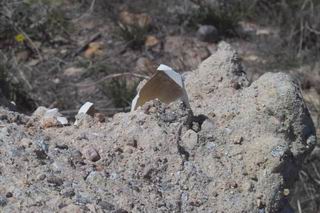
From that time onward, our working hypothesis was that we would never find anything near a site that had concrete foundations. We sought out the most rugged, isolated, inaccessible sites. One section of the line, running through Piru canyon, fit the bill perfectly. Electrical World had this to say: "A section here of about 5 miles involved very difficult work. Heavy angles, both vertical and horizontal, were necessary in a district where no permanent wagon road could be maintained, and where the tower footings were mostly in loose shale."
Many of the sites in this area are well off the old road, difficult to approach, and protected by an almost impenetrable sea of brush about 8 feet high. The lower third of the brush is dead and thorny, all the way to the ground. The upper two-thirds is live and thorny, and entangled with very tough vines. The brush in this part of the world burns ferociously at irregular intervals, usually 20 to 40 years. There had been wildfires on both sides of this small section of line within the last few years. By some miracle, this brush, tinder dry as it was, had survived for more than 85 years! After having our clothes torn up and enduring deep scratches on every part of our bodies, we finally learned to carry pruners, and prune a ``tunnel'' through the brush for access. Not only were the sites isolated and well-protected, but the towers in this area were removed by the Forest Service in 1973, at the time Pyramid Dam was constructed. No trace of a tower was visible until we were almost standing on it. Sure enough, many of these sites had no concrete. It was here that we started finding more than isolated, broken pieces.
